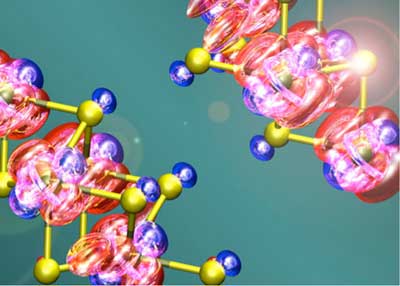| Posted: Apr 10, 2018 |
How to turn light Into atomic vibrations
(Nanowerk News) Sheet-like materials can have intriguing properties that could benefit devices from flexible electronics to solar cells. Researchers think they can customize the properties of these materials by using light pulses to rapidly switch the materials from one state to another. For example, light pulses could turn an electrical insulator into a conductor. But the ability to do this depends on how efficiently the light’s energy is transferred to the material’s atomic nuclei.
|
|
Now, researchers have shown, for the first time, that the conversion of light to atomic vibrations in thin sheets of molybdenum diselenide is very fast and efficient. In fact, the conversion is nearly 100 percent efficient and occurs in a trillionth of a second (Nature Communications, "Ultrafast non-radiative dynamics of atomically thin MoSe2").
|
 |
| A laser pulse instantly redistributes electrons (from red to blue) in a bi-layer of molybdenum diselenide. (Image: Hiroyuki Kumazoe, University of Southern California)
|
|
The study indicates a potential approach to control certain films with lasers. Scientists are interested in these films because the materials can be extremely strong and conductive. Controlling such films could aid next-generation applications. For example, it could benefit flexible electronics, data storage devices, solar cells, light-emitting diodes, and chemical catalysts.
|
|
Light could induce desirable structural changes in thin sheets of materials. These materials could have applications ranging from data storage devices to chemical catalysts. The challenge is truly understanding the real-time atomic motion and lattice temperature. Scientists have lacked the proper experimental techniques.
|
|
Using ultrafast electron diffraction, researchers directly probed the conversion of light energy to vibrations of the overall atomic lattice in a model two-layered semiconductor, molybdenum diselenide. The team found that when creating a high charge carrier density, the energy is efficiently transferred to the lattice within a trillionth of a second.
|
|
Computer simulations, specifically, first-principles nonadiabatic quantum molecular dynamics simulations, reproduced the conversion of light energy to lattice vibrations. The simulations further suggested that a softening of the vibrations in the light-induced excited state is a precursor to the efficient and rapid energy transfer.
|
|
Knowing how the film’s atomic lattice responds to lasers has implications for, one day, using light to control the electrical currents in devices.
|

